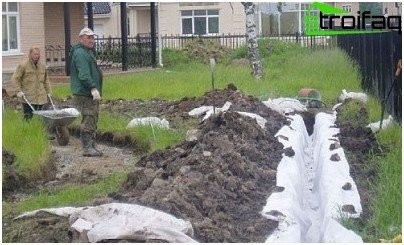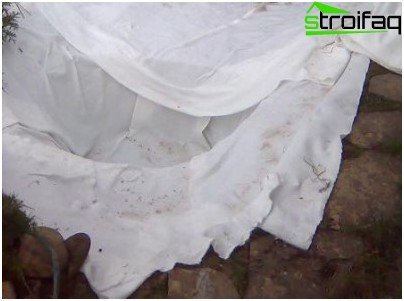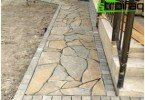What if you got a problem area with high humidity? A spoiling foundation, a poor harvest, constant puddles and kilograms of dirt on shoes – all this, no doubt, spoils the mood of any landowner. The first decision that comes to mind is to sell the territory. But what if you have already fallen in love with your possessions and never exchange this cozy place for another? Then do not be lazy, do the drainage of the site with your own hands and continue to enjoy your favorite surroundings.
Content
- Prerequisites for organizing a drainage system
- Drainage and its types
- How to do surface drainage yourself
- Drainage through deep drainage
Prerequisites for organizing a drainage system
The vagaries of nature in the form of frequent rains, isolated puddles in the garden, seasonal dirt in the garden – all this is no reason to sound the alarm and spend money on a drainage project. It is necessary to clearly distinguish when the land needs help, and in which cases the soil itself will cope with natural force majeure. Observe your possessions, draw conclusions and take up the drainage of the site, drainage of the land only in case of the following problems.
- Flooding of premises such as a cellar, ground floors and other buildings on the ground floor or slightly below ground level. Why are these phenomena dangerous? Damage to buildings, because excess moisture provokes the appearance and reproduction of mold, fungi and other misfortunes unnecessary for the landowner. Stairs, floors, furniture, other components of buildings – all this will begin to rot, will become worthless, ruin your mood and lead to losses;
- Waterlogging of the soil due to the fact that water will not be able to quickly go into the deep layers. You will have a bad harvest or its absence, rotted flowers, dead trees, and as a result – the disgusting appearance of your possessions;
- The washing out of the earth, which becomes noticeable due to constant failures, depressions on paths paved with stone or tile;
- Loosening the soil is the extreme stage of excess moisture when you need to take action immediately, otherwise the expanding soil will destroy not only the paths, but also lead to cracks in the foundation, walls, skew doors and windows, until your home turns into ruins.
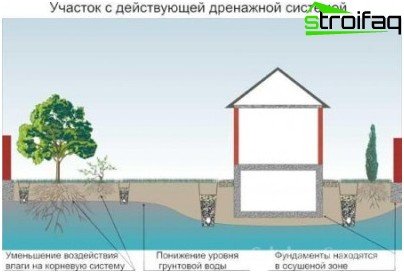
High-quality drainage provides year-round outflow of water
This is important to know! Design and installation of drainage on the site is an integral measure for those who own clay soil, in lowlands, areas with abundant groundwater, river valleys, regularly flooded by heavy rains or snowmelt, in drained marshlands.
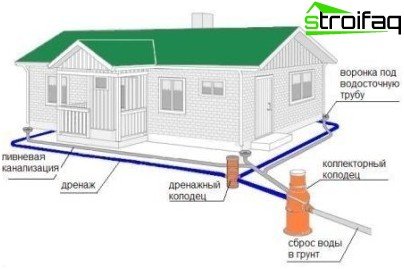
An example of the organization of the drainage system in the country
Drainage and its types
Drainage is a combined system of pipes and trenches located on a piece of land or along the entire perimeter of the territory, including structures on the site. The main objective of such actions is to protect buildings from moisture, to normalize soil moisture by diverting excess water beyond the boundaries of possessions.
You can order a project for site drainage from a specialized company or you can build a system for draining the soil with your own hands. As often happens, and in this case it all depends on your financial capabilities, time and desire.
Before studying how to make drainage on a site, you should decide which of its types to choose, because a competent choice and the correct order of work is the basis for the success of any operation.
So, the drainage system is of two types:
- Superficial, when a drainage system is made on the territory for excess moisture resulting from frequent rains and / or heavy snowmelt.
- Deep, which is relevant in the case of groundwater being located close to the surface, to protect buildings from destruction, and the garden, yard and garden from flooding.
Yes, such a serious “front” of work awaits you if you want to make a reliable drainage system
In turn, the surface drainage system is divided into the following types:
- linear,
- point.
The linear surface drainage system is most often a series of trays located with a special bias to the place of general moisture collection. Tanks are installed in ditches with a layer of gravel at the bottom. Such drainage of the summer cottage is effective if the soil slope exceeds 3 degrees relative to the horizon. Roughly speaking, when your possessions are below neighboring areas.
The point drainage system is a collection of drainpipes with a water intake. Such a device resembles a well, separated by a siphon partition – a grate, which is necessary to clean incoming moisture from debris so that the system does not become clogged and there is no unpleasant odor. Some landowners equip the receiving unit with a special waste bin..
This is important to know! Not one of the drainage systems is sufficient for each area, sometimes to maintain normal humidity you have to combine them.
How to do surface drainage yourself
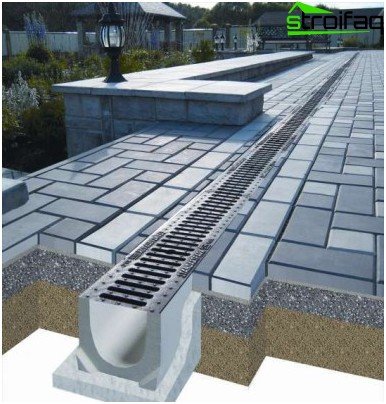
This is how the surface drainage system works
As already mentioned, the surface drainage system is a solution for an area suffering from heavy rainfall (rain, snow). Realizing such a project is much easier than building a deep drainage. Even a novice summer resident can do this kind of work. The main thing is a competent approach and the exact order of work.
Where to begin? Inspect the territory, make an indicative scheme of the placement of trenches. As a rule, main ditches run along the entire perimeter, and additional trenches are made in places of water accumulation. The ditch width recommended by the experts is 50 cm, the depth is 70 cm, the bevel of the walls is about 30 degrees. Auxiliary recesses are dug with a slope to the main trenches, and the latter with a slope to the collecting tank.
How to make a surface drainage system using trays? A layer (10 cm) of sand is poured into the ditches dug according to the above recommendations, which must be compacted. Place the selected trays on top and cover them with sand and waste traps. In order not to spoil the landscape and prevent the ingress of large debris into the system, it is recommended to close the trenches with grates.
Worth paying attention to! Which trays to choose for surface drainage? You are free to resolve this issue. You can buy plastic or make concrete (you can also with the addition of polymers) containers.
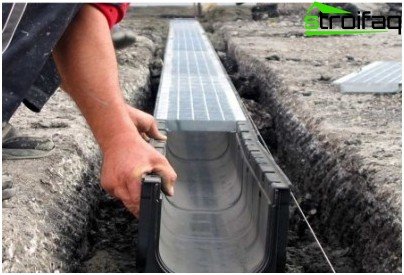
To organize reliable surface drainage, experts recommend purchasing special trays.
Meanwhile, some landowners do without trays. Then the recesses in 2/3 of the parts are covered with large gravel. This is followed by a layer of small gravel, and on top – a sod. To improve the operation of such a drainage system, crushed stone can be wrapped with geotextile.
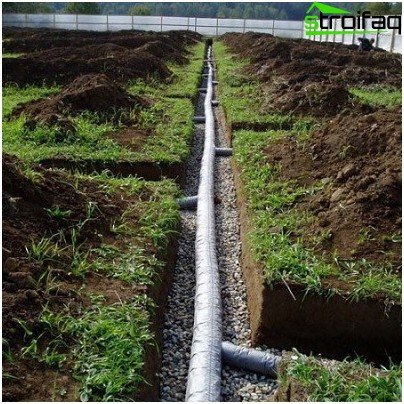
It looks like a faithfully made deep drainage system
Drainage through deep drainage
The main rule of creating an effective system of deep drainage is the placement of pipes at a depth below the passage of groundwater. If you have serious problems, you can seek professional help from a hydrogeological company, whose employees will accurately identify the level of pipe laying, and possibly develop a plan for the drainage system. Do not need such services, because nothing threatens your buildings, and you can do it yourself in the garden? Proceed in a proven set of summer residents. On mineral soils, dig ditches 60-150 cm deep, adhering to the following standards:
- the area around fruit trees is 120-150 cm;
- area near forest trees – 90 cm;
- the territory of flower beds, lawns, flower beds – 60-80 cm.
The recess width recommended by professionals is 40 cm.
This is important to know! If the soil on your possessions is peaty, then experts advise making trenches at least 1 meter deep, since such soil quickly settles.
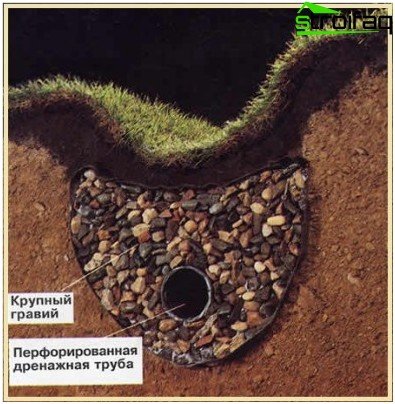
Sectional example of deep drainage
To create a deep drainage system, special pipes with a network of holes with a diameter of 0.15-0.5 cm are used. It is not worthwhile to use asbestos-cement or ceramic pipes that have been lying around since the Soviet era, since such materials have poorly recommended themselves “in practice” (they require frequent washing for soon clogging). Today, for such work, there are perforated polymer pipes, some of them are even equipped with a filter shell, which prevents clogging of the structure.

For deep drainage you need to purchase special perforated pipes
Work order:
- In a dug ditch, a layer of sand is poured and compacted (up to 10 cm).
- The trenches are covered with geotextiles so that the edges of the canvas are above the recess.
- This is followed by a layer (20 cm) of crushed stone.
- Pipes are laid on top.
- The structure is covered with crushed stone to half the height of the ditch.
- Next, you need to roll geotextiles, which will allow water to pass through, but retain soil particles and debris.
- The remaining half of the recesses is covered with loam and fertile soil..
- The complex of work is completed by the creation of wells located at the lowest points of the site, from which water can be drained into a storm sewer, ravine or the nearest body of water.
Geotextiles – a kind of filter that protects the system from clogging
Deep drainage is good because it is virtually imperceptible. Only you know that it exists on the territory. But to create such a system will have to work hard.
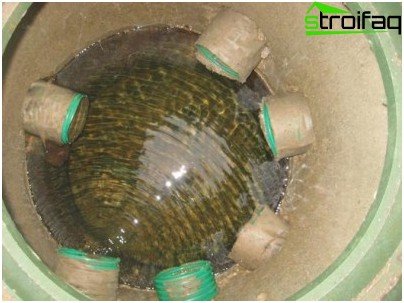
To drain the water you have to make such wells
Having done the drainage of the site, you protect the buildings, the garden and the vegetable garden from the negative effects of moisture and turn the problem land into a favorite vacation spot.


